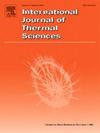Photon tunneling mechanism and performance analysis of near-field thermophotovoltaic system with plasmonic emitter
IF 4.9
2区 工程技术
Q1 ENGINEERING, MECHANICAL
International Journal of Thermal Sciences
Pub Date : 2025-03-29
DOI:10.1016/j.ijthermalsci.2025.109886
引用次数: 0
Abstract
Performance of thermophotovoltaic (TPV) system can be significantly improved by incorporating photon tunneling. In the near-field thermophotovoltaic system (NF-TPV) containing plasmonic emitter, where surface plasmon polaritons (SPPs) excited at the vacuum-plasmonic emitter interface may couple with total internal reflection (TR) mode to result in the TR-SPPs mode, or other electromagnetic modes. In this work, we investigate the photon tunneling mechanism and its impact on the performance of NF-TPV system with plasmonic emitter. Analytical formula of the dispersion relation of the TR-SPPs mode is derived. The mechanism of self-coupled SPPs mode is clarified. These mechanisms undergo transitions at different separation distances. As the distance decreases, TR-SPPs mode is suppressed, while the self-coupled SPPs mode progressively assumes a dominant role, which significantly enhances the spectral radiative heat flux surpassing the bandgap. The spectral changes increase the power density as the distance decreases. Especially, the efficiency can be significantly improved when NFRHT is primarily mediated by the self-coupled SPPs mode. These findings enhance the comprehension of photon tunneling mechanism and provide guidance for NF-TPV system design and optimization.

等离子体发射器近场热光伏系统的光子隧穿机理及性能分析
利用光子隧穿技术可以显著提高热光伏系统的性能。在含有等离子体发射器的近场热光伏系统(fn - tpv)中,在真空等离子体发射器界面激发的表面等离子体激元(SPPs)可能与全内反射(TR)模式耦合产生TR-SPPs模式或其他电磁模式。本文研究了光子隧穿机制及其对等离子体发射器NF-TPV系统性能的影响。导出了TR-SPPs模式色散关系的解析公式。阐明了自耦合SPPs模式的机理。这些机制在不同的分离距离上发生转变。随着距离的减小,TR-SPPs模式被抑制,而自耦合SPPs模式逐渐占据主导地位,显著增强了超过带隙的光谱辐射热通量。随着距离的减小,光谱的变化增加了功率密度。特别是当NFRHT主要由自耦合SPPs模式介导时,效率显著提高。这些发现增强了对光子隧穿机理的理解,为NF-TPV系统的设计和优化提供了指导。
本文章由计算机程序翻译,如有差异,请以英文原文为准。
求助全文
约1分钟内获得全文
求助全文
来源期刊

International Journal of Thermal Sciences
工程技术-工程:机械
CiteScore
8.10
自引率
11.10%
发文量
531
审稿时长
55 days
期刊介绍:
The International Journal of Thermal Sciences is a journal devoted to the publication of fundamental studies on the physics of transfer processes in general, with an emphasis on thermal aspects and also applied research on various processes, energy systems and the environment. Articles are published in English and French, and are subject to peer review.
The fundamental subjects considered within the scope of the journal are:
* Heat and relevant mass transfer at all scales (nano, micro and macro) and in all types of material (heterogeneous, composites, biological,...) and fluid flow
* Forced, natural or mixed convection in reactive or non-reactive media
* Single or multi–phase fluid flow with or without phase change
* Near–and far–field radiative heat transfer
* Combined modes of heat transfer in complex systems (for example, plasmas, biological, geological,...)
* Multiscale modelling
The applied research topics include:
* Heat exchangers, heat pipes, cooling processes
* Transport phenomena taking place in industrial processes (chemical, food and agricultural, metallurgical, space and aeronautical, automobile industries)
* Nano–and micro–technology for energy, space, biosystems and devices
* Heat transport analysis in advanced systems
* Impact of energy–related processes on environment, and emerging energy systems
The study of thermophysical properties of materials and fluids, thermal measurement techniques, inverse methods, and the developments of experimental methods are within the scope of the International Journal of Thermal Sciences which also covers the modelling, and numerical methods applied to thermal transfer.
 求助内容:
求助内容: 应助结果提醒方式:
应助结果提醒方式:


